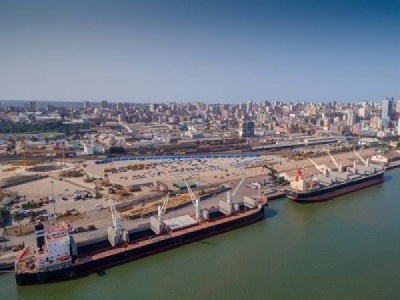
Posted on March 8, 2018
By Felicity Landon, portstrategy
There was quite an accolade for Maputo Port Development Company (MPDC) at the opening of the International Fair of Mozambique last year. MPDC received an award for being the country’s biggest investor in infrastructure during 2012-2016.
The past few years have seen a transformation of the port, based on a masterplan envisaging $2bn of investment – $800m of which has already been invested.
As well as two major channel deepening projects, in 2011 and 2016, the port has seen the construction of an intermodal container depot terminal, the expansion of four terminals (car, ferry, coal terminal and container terminals), the construction of new warehouses and refurbishment of old ones, berth upgrades, and new road and rail accesses.
MPDC, a partnership between the Mozambican Ports and Railway Company and a consortium of Grindrod, DP World and Mozambique Gestores, has stated its ambition to be handling 30m tonnes by the end of its concession period in 2033.
The completion of the most recent dredge, officially marked at the start of 2017, deepened the access channel from 11 to 14.4 metres, enabling the port to receive capesize vessels. “Until very recently, these same ships had to make double stops – one in our port and another in another port in the region or even be diverted to neighbouring ports,” says Osório Lucas, MPDC’s chief executive, at the ceremony to mark the completion of the work.
This project, he said, would transform Maputo ‘not into an alternative port but into a port of choice’.
Volume growth
Total cargo volumes through Maputo increased by 22% in 2017, to 18.2m tonnes, compared with 14.9m tonnes in 2016. The deeper access channel was the major factor in this growth. As Mr Lucas points out, the port received 955 vessel calls in 2016 and 896 in 2017 – “which means 59 less ships but an additional 3.3m tonnes of cargo”.
Jan de Nul Dredging Middle East finished the dredging three months before the deadline, removing about 14.5m cubic metres of sediment and rock in a project that cost a total $84.1m.
Following this, Maputo moved into bunkering services for all vessels, moored or at anchorage. Fuels and lubricants are being provided in an agreement between MPDC and Petromoc Bunkering.
The dredging also sparked other investments, including at the Matola Coal Terminal (TCM), an open storage dry bulk terminal handling coal and magnetite, where an existing berth pocket has been dredged to 15.4 metres to accommodate fully laden panamax vessels, and a new fender support structure and fender system has extended the quay by 8.5 metres.
Also in 2017, the DP World Maputo Container Terminal began expansion work to increase capacity from 150,000 to 250,000 teu. This work included the expansion of two rail sidings. A second phase of expansion, dependent on market demand, will increase capacity to 450,000 teu.
Maputo is also gearing up to receive even deeper draft vessels, with the reworking of berths 6, 7, 8 and 9 – a total 1,058 meters of quay – due to begin in the second quarter this year. This represents the last major works package outlined in the port’s master plan. The work will provide berths with depth alongside of up to 15 metres and also improve occupation rate through the creation of a bigger and deeper mooring area.
Connectivity
Rail freight volumes have grown in recent years, the result of a joint strategy between the port and the CFM, and this growth continued in 2017. This was particularly the case with chrome ore and ferro-chrome, which are major cargoes at the port. The volume of these materials carried by rail almost doubled from 411,000 tonnes in 2016 to nearly 1m tonnes in 2017.
However, as road continues to dominate, the port has stated its commitment to improve efficiency and promote a better balance between rail and road freight. “We believe that the various initiatives undertaken in 2017 will have a direct impact on the growth of rail volumes this year,” said Mr Lucas.
Meanwhile, the skyline has changed dramatically for the port, with the construction of the 3-kilometre Maputo-Catembe Bridge. The longest suspension bridge in Africa, it links the capital with the Catembe district and will cut journey times by eliminating the need to drive around the bay or use some of the ageing ferry services. It is expected to create significant employment and growth and boost international trade.
The bridge has been built 60 metres above Maputo Bay to ensure that ships can pass underneath to and from the port. Significant new road infrastructure linked to the project will provide new links north-south and east-west in the country and create a connection with Swaziland and South Africa.
Source: Portstrategy





